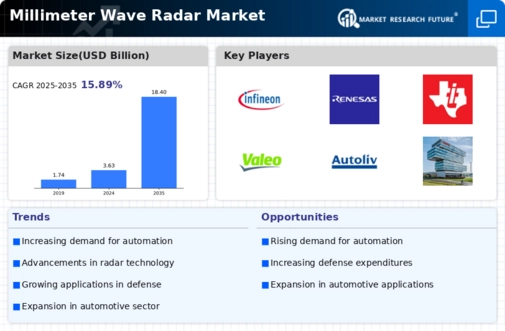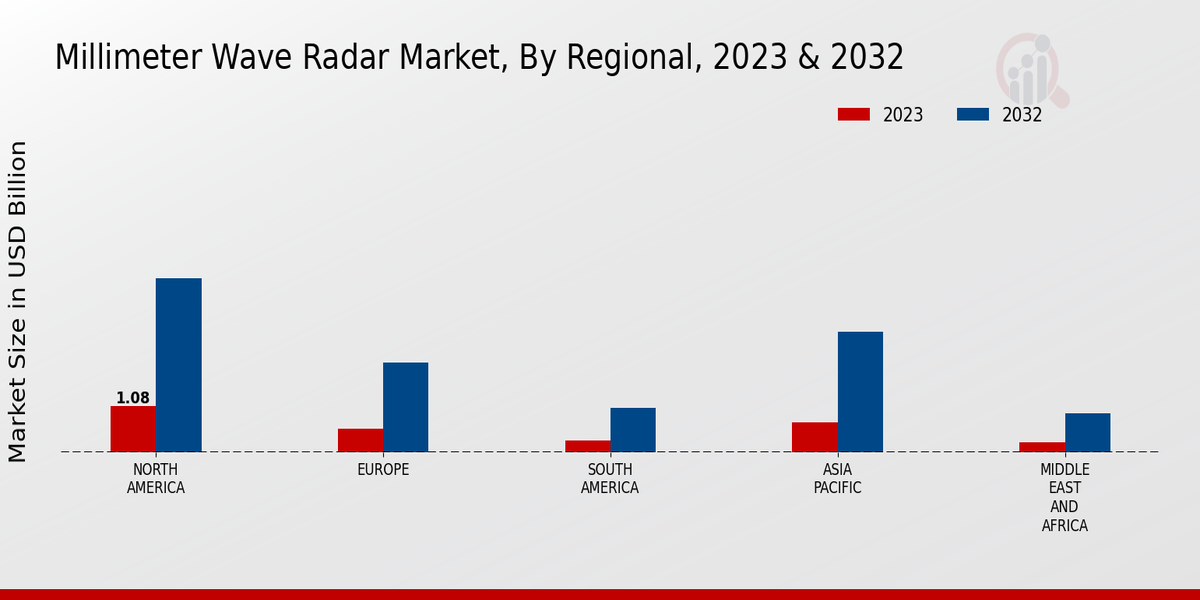Market Growth Projections
The Global Millimeter Wave Radar Market Industry is projected to experience substantial growth, with forecasts indicating a rise from 3.63 USD Billion in 2024 to 18.4 USD Billion by 2035. This growth trajectory reflects a compound annual growth rate (CAGR) of 15.88% from 2025 to 2035, driven by various factors including technological advancements, increased demand in automotive and defense sectors, and expansion in telecommunications. The market's evolution is indicative of the broader trends in radar technology, where applications are diversifying across multiple industries, thus reinforcing the significance of millimeter wave radar in contemporary technological landscapes.
Technological Advancements
The Global Millimeter Wave Radar Market Industry is experiencing rapid technological advancements, particularly in radar systems that enhance detection capabilities and accuracy. Innovations in semiconductor technology, such as the development of high-frequency components, are enabling more compact and efficient radar systems. For instance, the integration of advanced signal processing algorithms allows for improved target recognition and tracking. This evolution is crucial for applications in automotive, aerospace, and defense sectors, where precision is paramount. As a result, the market is projected to grow from 3.63 USD Billion in 2024 to 18.4 USD Billion by 2035, reflecting a robust demand for cutting-edge radar solutions.
Growing Defense Expenditure
Global military modernization efforts are propelling the demand for millimeter wave radar systems within the defense sector. Nations are investing heavily in advanced surveillance and reconnaissance technologies to enhance national security. Millimeter wave radar provides superior detection capabilities in various environments, making it an essential component of modern defense systems. For example, countries are deploying these radars in unmanned aerial vehicles (UAVs) and missile defense systems. This increasing defense expenditure is expected to significantly contribute to the growth of the Global Millimeter Wave Radar Market Industry, as governments seek to bolster their military capabilities.
Expansion in Telecommunications
The telecommunications industry is witnessing a transformative shift towards millimeter wave technology, driven by the demand for higher bandwidth and faster data transmission. The Global Millimeter Wave Radar Market Industry is benefiting from the rollout of 5G networks, which rely on millimeter wave frequencies to deliver enhanced connectivity. This expansion is not only facilitating faster internet services but also enabling the proliferation of Internet of Things (IoT) devices. As telecommunications companies invest in infrastructure to support these advancements, the market for millimeter wave radar is poised for substantial growth, aligning with the broader trends in digital communication.
Emerging Applications in Healthcare
The healthcare sector is increasingly recognizing the potential of millimeter wave radar technology for various applications, including medical imaging and patient monitoring. The Global Millimeter Wave Radar Market Industry is likely to expand as healthcare providers seek innovative solutions for non-invasive diagnostics and real-time monitoring of vital signs. For instance, radar systems can be utilized to detect respiratory patterns and heart rates without direct contact. This emerging application not only enhances patient care but also aligns with the growing trend of telemedicine. As healthcare technology evolves, the integration of millimeter wave radar is expected to play a pivotal role in shaping future medical practices.
Increased Demand in Automotive Sector
The automotive sector is a significant driver for the Global Millimeter Wave Radar Market Industry, particularly with the rise of advanced driver-assistance systems (ADAS). These systems utilize millimeter wave radar for features such as adaptive cruise control, collision avoidance, and parking assistance. As automotive manufacturers increasingly prioritize safety and automation, the demand for millimeter wave radar technology is expected to surge. This trend is evidenced by the projected compound annual growth rate (CAGR) of 15.88% from 2025 to 2035, indicating a strong market trajectory driven by the integration of radar systems in vehicles.



















